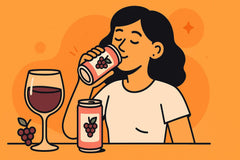Wine, often referred to as the nectar of the gods, has captivated connoisseurs for centuries. The idea that wine improves with age is deeply ingrained in wine culture, but does it hold true for all wines? Can you confidently open a 20-year-old bottle, or even consider sipping a century-old vintage? In this article, we'll explore the mystique of aging wine, uncover which wines truly benefit from time, and reveal the oldest drinkable wine on record.
The Age-Old Myth: Does Wine Keep Getting Better with Age?

The notion that wine gets better with age is both true and false, depending on the type of wine in question. In reality, only a small percentage of wines improve significantly over time. Age-worthy wines typically possess certain characteristics that make them suitable for aging, including high tannin levels, acidity, and complexity.
Is 20-Year-Old Wine Still Good?
The answer to this question depends on the wine. For many red wines, particularly those made from grapes like Cabernet Sauvignon, Nebbiolo, and Bordeaux blends, a 20-year-old bottle can be a delightful experience. These wines often develop complex aromas and flavors that are not present in younger versions.
However, the same cannot be said for most white wines and lighter reds. These wines are usually best enjoyed when they are young and fresh, with their primary fruit flavors intact. Opening a 20-year-old Chardonnay may result in a flat and oxidized wine.
Can You Drink 100-Year-Old Wine?

While it's technically possible to find 100-year-old wines, their drinkability is highly questionable. Few wines are built to withstand such extended aging, and even well-preserved bottles may have passed their prime. Opening a century-old bottle is often more about experiencing history than savoring a stellar wine.
What Percentage of Wine Gets Better with Age?
A mere 1% to 5% of all wines are suitable for long-term aging. These wines are typically characterized by their robust structure, high acidity, and the potential to evolve over time. The vast majority of wines, however, are meant to be consumed within a few years of their vintage to enjoy their fresh and vibrant flavors.
What Wines Should Not Be Aged?

Ah, the art of aging wine, a fine dance between patience and anticipation. While some wines gracefully waltz through time, others stumble and fall flat on their corked faces. Let's explore the wines that should not be aged – the restless spirits that refuse to play the long game.
1. Most Whites - The 'Stay Youthful' Club: White wines, those sprightly souls, are like the Peter Pans of the wine world. They thrive on their youthful vigor, bursting with vibrant citrus and floral notes. Attempting to age them is akin to sending Peter Pan off to retirement – it just won't end well. Chardonnay, Sauvignon Blanc, and their cohorts should be enjoyed young and fresh, capturing their essence at the peak of exuberance.
2. Light Reds - The 'Eternal Spring' Gang: Light-bodied red wines, like Pinot Noir or Beaujolais, are the eternal springtime in a bottle. Delicate, charming, and fruity, they embody the joie de vivre of life. Aging them is like telling a spring lamb it should aspire to be a grizzled old ram – unnecessary and slightly absurd. Pop the cork, enjoy the youthful exuberance, and embrace the lightness of being.
3. Everyday Sippers - The 'Live for Today' Bunch: Those trusty, wallet-friendly wines you reach for after a long day's work are your everyday companions. But aging them is like sending your favorite t-shirt through a time machine - it might come out faded and tattered. These wines are crafted for immediate gratification, not a patient rendezvous in the cellar. Embrace their simplicity and drink them while they still radiate their affordable charm.
What Is the Oldest Drinkable Wine?
Picture this: you're holding a bottle of wine that has weathered the tempests of time, a liquid time capsule from an era long gone. It's not just wine; it's history in a bottle, a sip that connects you with civilizations that have crumbled to dust. But where can you find these ancient treasures, and what's the secret behind their age-defying drinkability?
1. The Time-Traveling Vessel: Our quest for the oldest drinkable wine transports us to a wine bottle that's more seasoned than your great-great-grandmother's apple pie recipe. Meet the Speyer wine bottle, an archaeological marvel discovered in a Roman tomb near Speyer, Germany. Its origins? A jaw-dropping 1,700 years ago, around 325 AD. This isn't just a wine bottle; it's a TARDIS in glass.
2. The Preservation Paradox: Now, how on Earth (or buried beneath it) does wine manage to survive the relentless march of time? The Speyer bottle's secret sauce is its sealed glass sanctuary. It's like wine hibernation – no contact with oxygen, no sneaky contaminants. Just the wine, locked in its centuries-long slumber.
3. A Taste of Antiquity: But what about the flavor? Ah, that's where it gets truly fascinating. Imagine a sip that whispers secrets of an ancient vineyard. As this wine ages, it's a shape-shifter. Over centuries, it metamorphoses into something akin to liquid history. You might detect notes of honey, hints of nuts, or a touch of dried fruit. It's a flavor adventure, a taste bud time machine.
Conclusion: Savoring the Vintage Wisdom of Wine

In the world of wine, the question of whether it gets better with age isn't one-size-fits-all. It's a nuanced tale of grapes, patience, and discernment. While the allure of aged wine can be irresistible, it's essential to recognize that not all wines are destined to become timeless classics.
As we've journeyed through the labyrinth of wine aging, we've uncovered that only a select few, boasting robust structures and complex personalities, are worthy candidates for the cellar. For the rest, it's all about celebrating their youthful exuberance, sipping them at their freshest, and savoring the vibrancy of the present moment.
So, whether you find yourself enchanted by a 20-year-old Cabernet Sauvignon's symphony of flavors or basking in the exuberance of a zesty Sauvignon Blanc, remember that wine's magic lies in its diversity. Each bottle has its own story to tell, and it's up to us to listen attentively.
As we raise our glasses to the world of wine, let's toast to the wisdom of knowing when to savor, when to age, and when to embrace the timeless joy of a well-paired bottle. Wine, like life, is a journey – one to be relished, shared, and cherished, sip by sip, vintage by vintage.
And if you're ready to explore the world of exceptional wines, why not start with Graham + Fisk's Wine in a Can? They offer a delightful selection of wines that are perfect for any occasion, whether you're enjoying them young or embracing the aged beauty of your favorites. Our cans stay good for over 2 years, and re-upping on wine is as easy as placing an Amazon order! Cheers to the art of aging and the enchanting world of wine!







